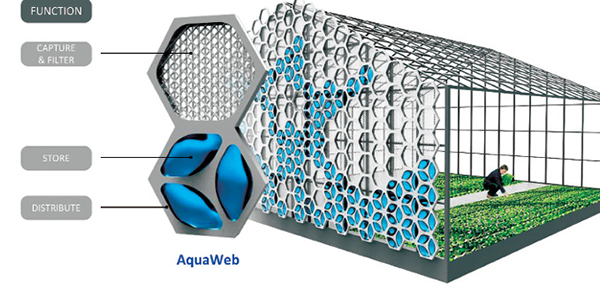
Team NexLoop won the $100,000 Ray C. Anderson Foundation Ray of Hope Prize in 2017 for its AquaWeb prototype that mimics the way living systems capture, store and distribute water. Image courtesy of NexLoop via the Biomimicry Global Design Challenge.
Latest News
January 1, 2019
The Biomimicry Global Design Challenge (BGDC) is hosted in partnership with the Ray C. Anderson Foundation. The annual competition invites university students and professionals to address sustainability issues, critical to environmental stewardship and concerns, with nature-inspired solutions. The challenge is open to students and professionals anywhere.The challenge calls on students to addressthe institute’sfocus of biomimicry—the design and production of materials, structures and systems modeled on biological entities and processes.
Megan Schuknecht is the director of design challenges at the Biomimicry Institute. We spoke to her to learn about thedesign challengeand the types of projects they see.
Digital Engineering: Can you provide an overview of The Biomimicry Global Design Challenge competition, how it came to be and the intent of the program?
Megan Schuknecht: Biomimicry is a design approach that emulates living systems in order to create healthier, more sustainable materials, products, buildings and systems. The idea is that by mimicking strategies and patterns from the natural world, we can create radically sustainable solutions more quickly.
We created the Biomimicry Global Design Challenge to provide free biomimicry learning opportunities to anyone around the world and, ultimately, to help more biomimetic sustainability solutions become commercialized. We held our first Biomimicry Global Design Challenge (BGDC), open to both university students and professionals, in 2015 and have been hosting annual global challenges ever since around themes such as food systems and addressing climate change. We invite challenge finalists to enter the Biomimicry Launchpad, an accelerator program that supports early-stage entrepreneurs trying to bring nature-inspired technologies with significant social or environmental benefits to market. Each year, the winner of the Launchpad is awarded the $100,000 Ray of Hope Prize, which honors the late Ray C. Anderson and his belief in the power of business to be a force for good and to have purpose. Both the program and the Ray of Hope Prize are sponsored by our partner, the Ray C. Anderson Foundation.
Participants in the BGDC come from all over the world—from 51 countries to date, and every continent except Antarctica. We’vehad winners from Estonia, Taiwan, Brazil, Sweden, Mexico, the U.S., Canada and more—it’struly an international competition.
Anywhere from 65 to 120 teams participate annually, and most teams are made up of university students or young professionals. Individually, we’vehad over 2,400 participants over the years. And because nature-inspired design can be applied anywhere, we attract participants from a wide swath of disciplines, including engineering, architecture, design fields, business, biology, materials science, computer science and more. Approximately 15% of our teams continue to evolve their designs, either as entrepreneurs or through thesis work or academic studies.
DE: Can you tell us about some of the designs that are part of the event and how they came to be?
Schuknecht:Many of our teams use CAD, simulation software and 3D printing to produce their designs and prototypes, though we also encourage sketching and building by hand to better understand both the biology and how the technical components of their designs work. NexLoop, a team working at the food-water-energy nexus, learned lessons from epiphytes, orb weaver spiders and ice plants on how nature captures water and applied what they learned to create a product called AquaWeb (using 3D printing), which harnesses water from rain, fog or humidity to be used in urban food production. They’ll be installing their first large pilot system on GovernorsIsland in New York Harbor in early 2019.
Nucleário, a team from Brazil that is addressing challenges within forest restoration, was the winner of the 2018 Ray of Hope Prize (NexLoop won in 2017). Traditional Atlantic rainforestrestoration in remote areas is logistically challenging and requires manual work for three years after planting to maintain the seedlings. It also requires a lot of chemical inputs. The Nucleário planting system, made with biodegradable materials, ensures that seedlings survive by providing protection from leafcutter ants, collecting water from rain and dew, offering shade and protecting against invasive species, such as the Brachiaria grass that is now pervasive in much of the 17 million acres of former Atlantic rainforestthat are ripe for restoration. In the field, the Nucleário[system]improves the working conditions of the planting teams and reduces the costs of labor, transport, irrigation, fertilizers and insecticides.
Next year the BGDC will be featuring categories to enter, rather than themes, so you can expect to see a broader set of solutions in the future.
DE: Can you provide some examples of what the event has produced or what you expect it to produce?
Schuknecht:First and foremost, the BGDC and Launchpad have produced designers and entrepreneurs who are passionate about biomimicry and applying nature-inspired design to their work. They have become part of the broader community of people who recognize that earth has planetary limits that are fixed. These radical new designers and engineers will be the basis for a new economy. As Ray C. Anderson said: “We have to change from the extracting, wasteful, abusive system of the first Industrial Revolution to the waste-free and benign Second Industrial Revolution,” and these young entrepreneurs are leading the way.
The Launchpad element of the Challenge has just begun its fourth year, and already our 31 teams have started 11 businesses and filed for at least 13 patents. Teams have collectively received over $900,000 in follow-up funding, and eight teams have participated in additional accelerator or incubator programs. As the program grows, we expect to see more commercialized sustainability solutions on the market—all inspired by nature, of course.
More Info
Subscribe to our FREE magazine, FREE email newsletters or both!
Latest News
About the Author
Jim Romeo is a freelance writer based in Chesapeake, VA. Send e-mail about this article to [email protected].
Follow DE





